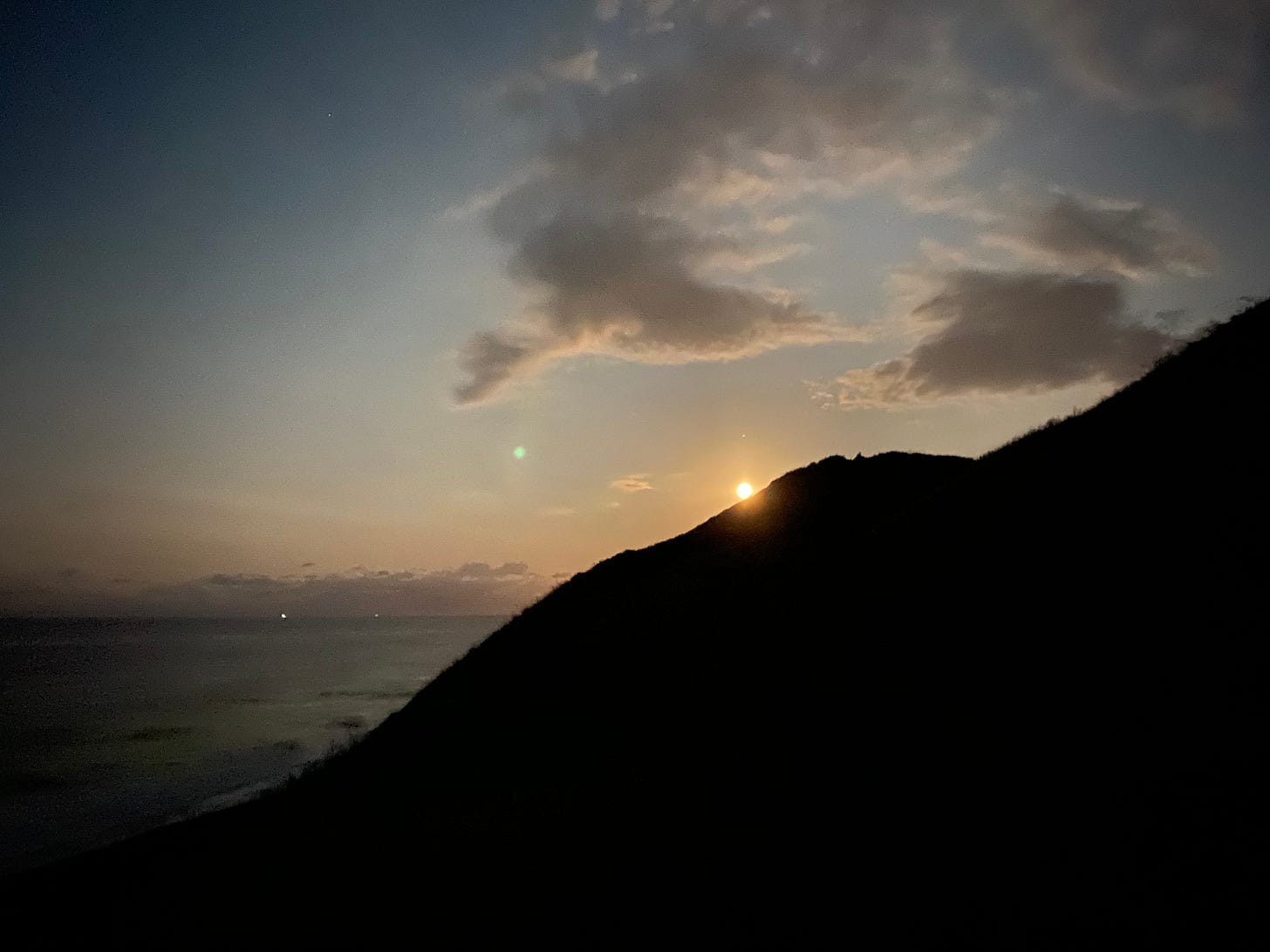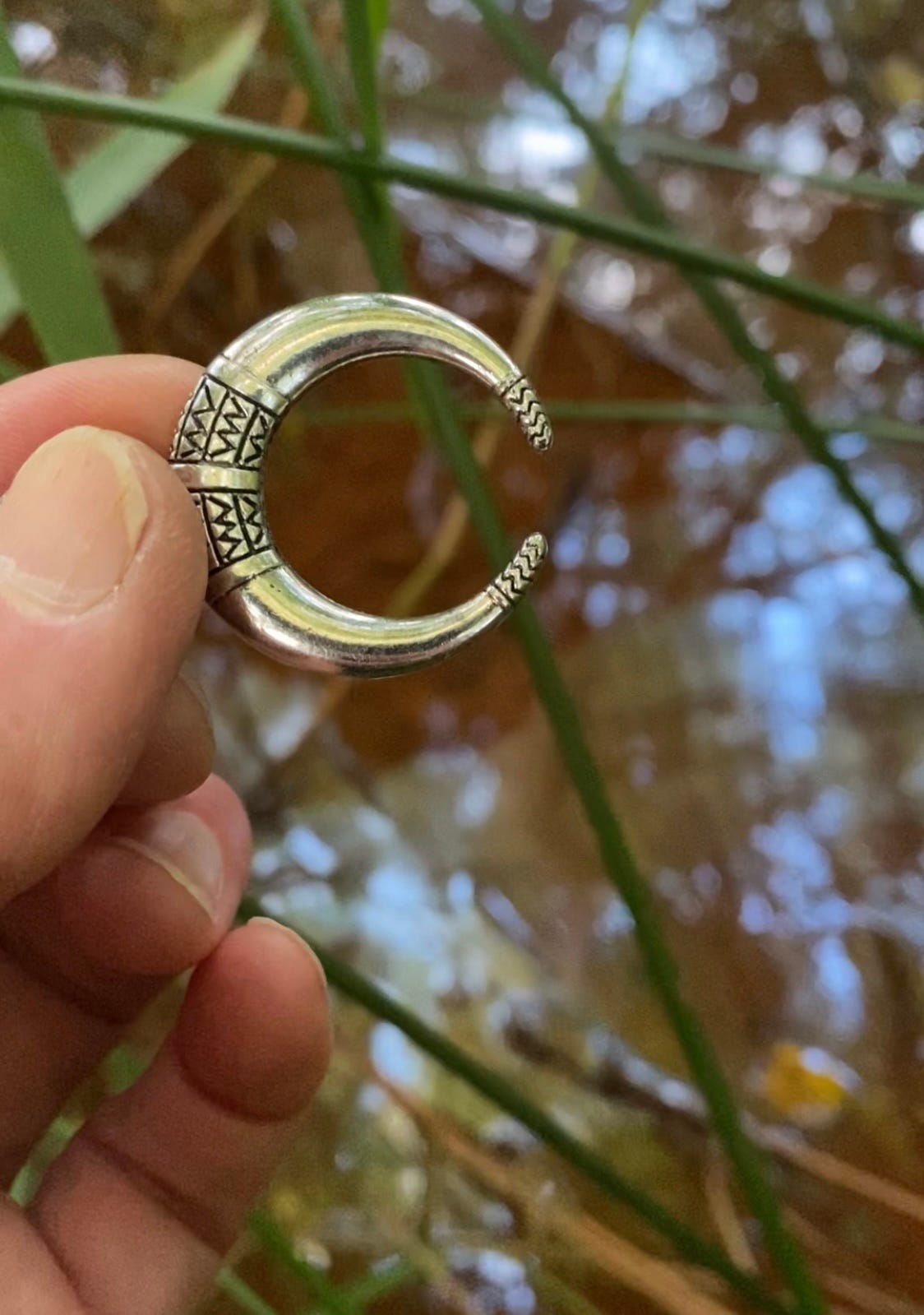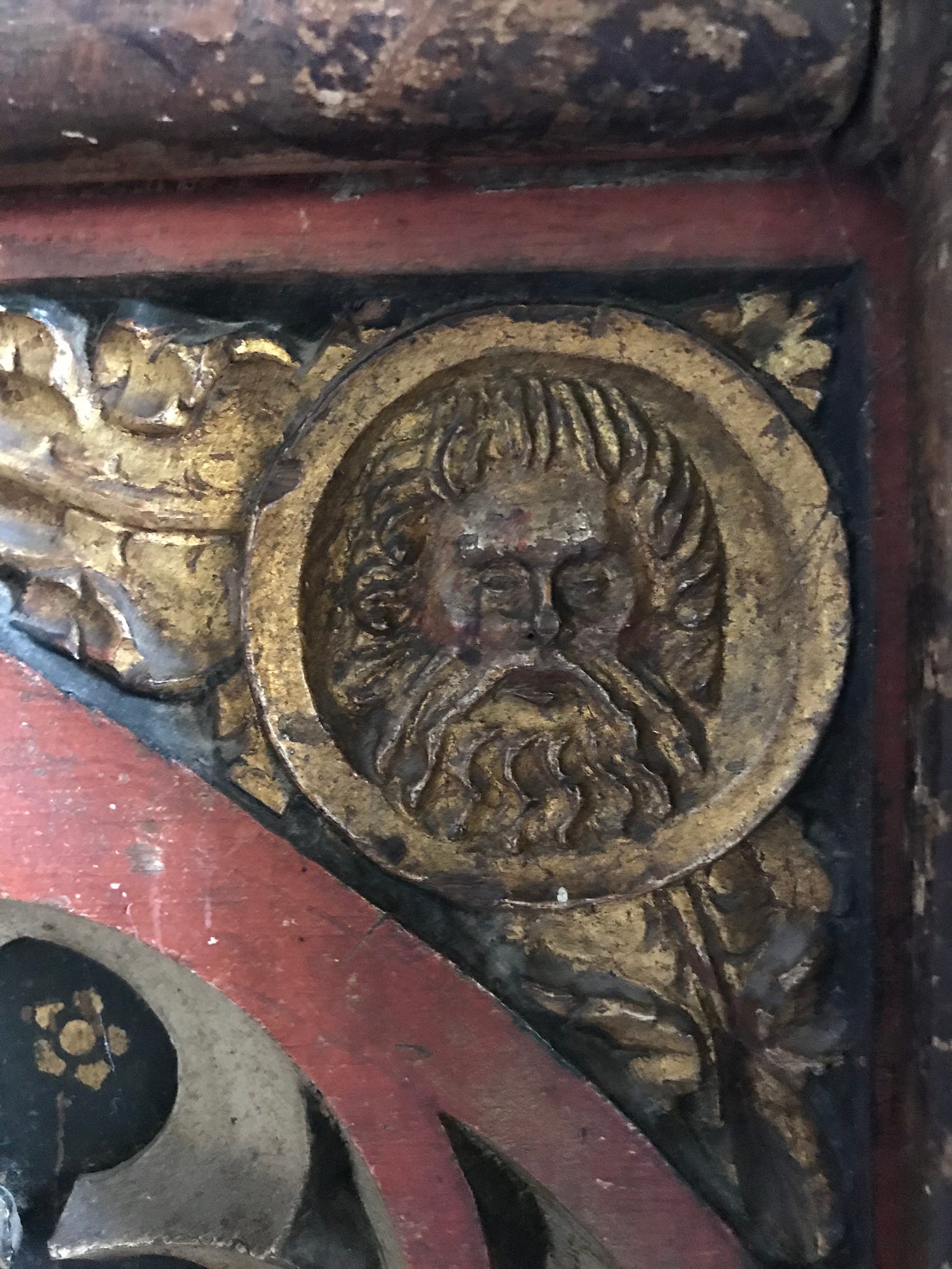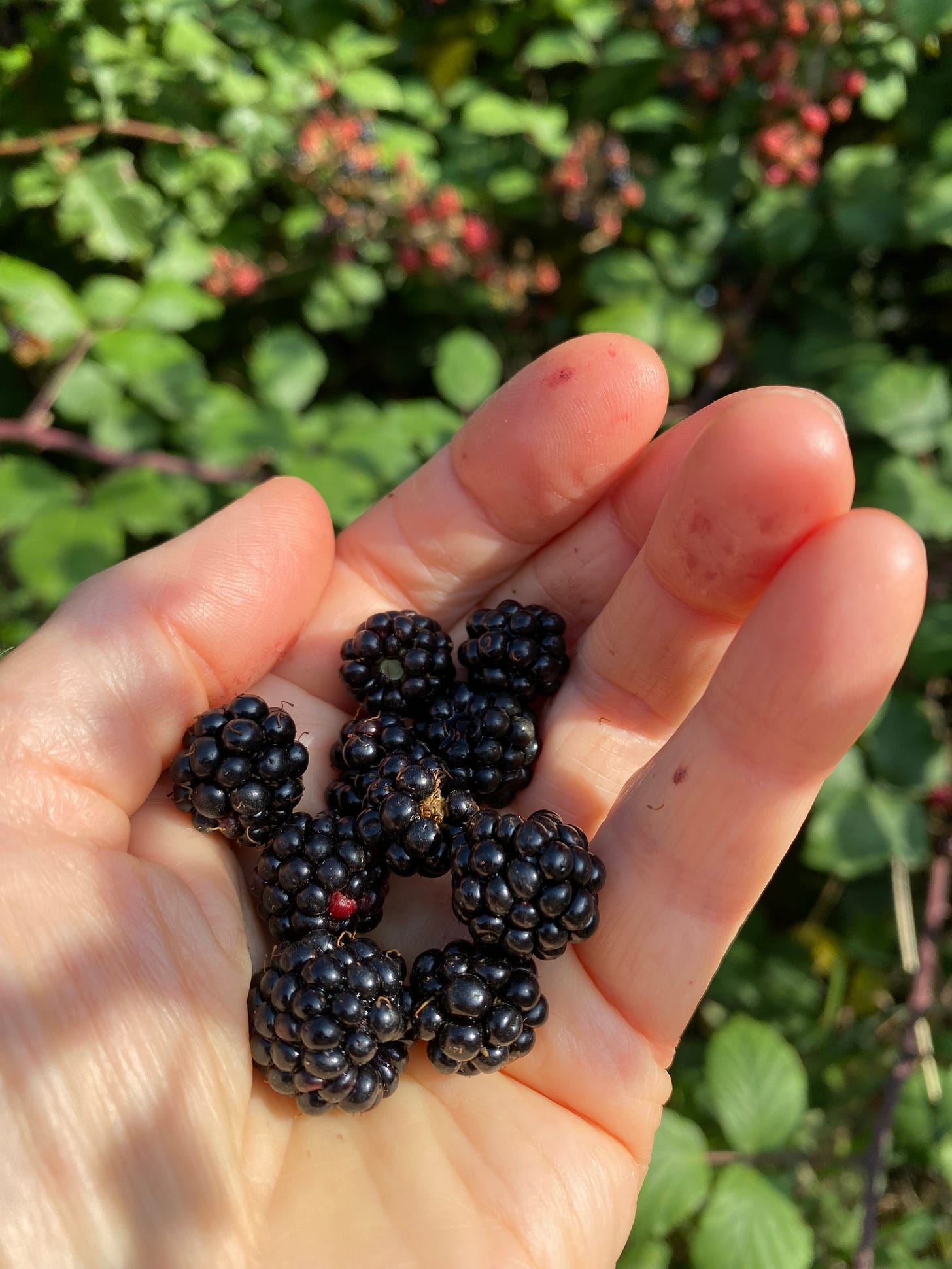The Rattling Grain
scattered chaff & reddening haws
I give thanks for arriving
Safely in a new dawn,
For the gift of eyes
To see the world,
The gift of mind
To feel at home
In my life.
The waves of possibility
Breaking on the shore of dawn,
The harvest of the past
That awaits my hunger,
And all the furtherings
This new day will bring.
John Donahue, On Waking
Ripening haws along the lane, 28 August 2023
It’s not very often that I can use this greeting; happy Blue Moon to you all!
One thing that feels strange, before we even begin, is that an extra full moon could fall in any season. And that means that this one, falling on the last day of August, doesn’t have the alternative names and folk practices from different cultures that we would normally be exploring.
So let’s work with what we have. On 30/31 August 2023 a Blue Moon shines brightly in the night sky. Especially brightly, since it’s also a Super Moon. This means it’s an even rarer phenomenon, a Super Blue Moon.
There are two different definitions for a Blue Moon. A seasonal Blue Moon is the third full moon of an astronomical season that has four full moons. A monthly Blue Moon is the second full moon in a calendar month with two full moons.
Why ‘Blue’ Moon?
Some believe that the term ‘once in a blue moon’ meaning something rare may have originated from when smoke and ashes after a volcanic eruption gave the moon a blue hue. Often, when people invoke the Blue Moon they mean that something is absurd and - like a blue moon - will never happen.
Seasonal Blue Moon
It’s because of the Ecclesiastical calendar that the third full moon of the season is ‘Blue’. The church calendar uses the phases of the moon to determine the date for Easter each year. This, of course, also affects Lent, which runs for 40 days beforehand. Lent-tide contains the final full moon of winter, the Lenten Moon. The first full moon of spring (also known as the Easter Moon or the Paschal Moon) falls just before Easter. Giving the third Moon of the season a generic name ensured that Lent and Easter would coincide with the right moon phases, and other celebrations and customs would still fall during their ‘proper’ times. According to the Farmers’ Almanac, the unlucky status of the number thirteen and the difficulties of calculating the occurrence of such a full moon led to the extra one being named a Blue Moon.
Monthly Blue Moon
The more popular definition of the Blue Moon, that of the second full moon in a month, owes its existence to a misinterpretation originally made by amateur astronomer James Hugh Pruett (1886 - 1955) in a 1946 edition of Sky & Telescope magazine. The error took on a life of its own and was spread around as fact. It even found its way into the answers of the 1986 version of the board game Trivial Pursuit. Today, it’s considered a second definition of the term Blue Moon rather than a mistake.
Honesty (Lunaria) with its silvery roundels is also known as Moonwort. It’s ready for drying at this time. When you strip off the casings the little moons are revealed in all their gleaming glory.
Once in a Blue Moon?
For a monthly Blue Moon to take place, a full moon must occur at the beginning of the month, as the interval between two successive full moons is approximately 29.5 days.
Seasonal Blue Moons take place slightly less frequently than monthly Blue Moons. In the 1100 years between 1550 and 2650, there are/will be 408 seasonal Blue Moons and 456 monthly Blue Moons. This means that either type of Blue Moon occurs roughly every two or three years.
Double Blue Moon
February, which has 28 days in a ‘normal’ year and 29 days in a leap year, can never have a monthly Blue Moon. In some years, February has no full moon at all. This is known as a Black Moon.
A February with no full moon happens when January and March have a Blue Moon each. Known as a Double Blue Moon, this rare phenomenon takes place only about three to five times in a century. We saw a Double Blue Moon in 2018 in most time zones and will see it again 19 years later, in 2037.
A final fact: two seasonal Blue Moons in a year is an impossibility, as that would require 14 full moons in the same year.
Well, I’m glad that this ‘nameless moon’ gave me the impetus to do that bit of research as there’s much here that I didn’t know!
Blue Moon or not, this full moon on the very cusp of September has a very different feel from the last one on the first day of August. Both are classed as Super Moons and I can vouch for the magnitude and brilliance of the light of last night’s Moon as it rose over the edge of the cliff.
Wishing you all the magic of that moon, washing over our dreams, plans and imaginings as we enter that most golden and mellow of months, September.
Full moon rising over the cliff edge, 30 August 2023
Moon-Treasure
Long ago, the moon used to shine just as she did last night. And when she shone, she cast her light over the marshland: the great pools of black water and the creeping trickles of green water … But when the moon did not shine, out came the Things that live in the darkness … The whole place teemed with boggarts and will-o’-the-wykes and other evil creatures … The marsh was no place to be after dark.
Kevin Crossley-Holland, The Dead Moon
In his retelling of the East Anglian folktale The Dead Moon, Kevin Crossley-Holland paints a vivid picture of the marsh and its hold over the lives and imaginations of the people who lived there.
When the moon shone, her light illuminated the squishy mounds that sucked anyone in who stepped on them, and people could walk around almost as safely as they could in broad daylight. But when the moon was not showing her face, bogles and dead things and crawling horrors had free rein and caused harm and mishap of all kinds.
In the story, the moon is troubled to hear of the bad things that happen behind her back and, at dark moon, she dons a black hooded cloak and comes down to earth to see for herself whether the situation is as diabolical as people make out. Disaster strikes when she becomes entangled in the peat and the bogles, witches and dead folk decide to drown her to stop her from shining and spoiling their fun. They drag her to the bottom of a deep dark pool and roll a huge stone on top.
The villagers look for the new moon but all stays dark and no crescent appears. Night after night the Things rampage over the marsh and no one dares leave their home. Eventually, following instructions from the local wise woman, the men of the hamlet manage to locate the pool and roll away the stone. But then the light came so quickly, and was so white and shining, that the men stepped back, stunned by it, and by the great angry wail raised by the fleeing horrors.
In this tale the moon is portrayed as kind and caring. For people of the watery places she would indeed have been a true friend. There is no full moon like the full moon reflected in the rippling river or picking out the criss-crossing marsh-paths and causeways with its silver sheen.
Our ancestors cast treasures into rivers, streams and marshy places in votive offering, their essence sacrificed to the spirits. Imagine waiting for nightfall to perform the ritual. Imagine looking up, waiting for the waxing moon to illuminate the glint of tumbling metal and then the ripples, sparkling, widening.
Casting moon-treasure into a tiny stream as part of my River Song candle project, August 2021.
Through the Trapdoor
One August day, nine years ago, the medieval church tower at Salle in Norfolk was opened to the public for the afternoon. I really, really wanted to experience my beloved local landscape spread out to the corners of the earth. As the opportunity was only offered once a year, I made myself overcome my fear of heights to ascend to the top.
You would not believe the number of times my husband and I had walked over the fields to this church. I usually had my eyes down, scanning the earth for worked flint fragments (and once, finding a 17th century gold coin). Meanwhile, he would be pointing out fantastical cloud formations beyond the horizon that I would never have thought to look up at. How exciting to to experience the land from the point of view of the tower jackdaws.
The stone staircase spiralled, steep and slightly crumbling. The worst thing was knowing there was someone above you and someone below, but I kept going. Eventually the stairs gave way to a ladder, which seemed to lead to a solid ceiling but to my horror actually gave onto a trapdoor through which you had to hoist yourself onto the roof of the tower. There was really no way back.
I crawled out into the sky. Euphoric, I sat for several moments on the warm, soft lead, eyes tightly closed.
And then, yes, I edged to the edge and gradually managed to open my eyes. And there it was, the earth shaken out and arrayed in all its glory just as it had been all the time.
How about you? Have you ever overcome a fear in order to experience something you knew you’d always regret not doing?
Just about managing to open my eyes, Salle church tower, Norfolk, August 2014.
The Wild Saint and his Head
Just along the coast at Trimingham lies a medieval church with a very distinctive dedication. It’s one of only three in the whole of England dedicated to The Beheading of St John the Baptist.
Although St John’s main feast day is, of course Midsummer Day, the Feast of the Beheading of John the Baptist takes place in late August, on the 29th of the month. Until recently I hadn’t realised that medieval churches were dedicated to saints’ feast days rather than to the actual saints themselves. Here, apparently in the early 20th century, the rather gruesome name was smoothed down to ‘St John The Baptist’s Head’. Whichever way you look at it, August 29 was a highly appropriate day for a visit.
As an aside, it has occurred to me that the timing of this festival during the harvest season might suggest that John is here taking the role of sacrificial John Barleycorn figure, being cut down to provide sustenance and to maintain the seasonal cycle before rising again in a different form. And we may also imagine a link with the prophesying head of the Celtic god Bran. Did pilgrims come here for counsel? Coincidentally (or not), Trimingham lies in North East Norfolk, the part of the county theorised to have been the centre of a Romano-British corvid cult, and Bran is associated with the raven.
The church might be quiet now, but in its late medieval heyday it was a mecca for pilgrims. In the entry for Trimingham on his Norfolk Churches website, Simon Knott tells us that was actually possible for English people to go and pray by the ‘real’ head of St John as it was kept just across the channel at Amiens Cathedral, where it can still be seen today. (As an aside, he rather spoils things by mentioning that it was kept at at least two other European cathedrals as well!) :
But rather than make that journey, it was possible to come and pray at the shrine altar here at Trimingham, where a life-sized alabaster carving of he head of St John the Baptist was on display. The head was probably destroyed by Anglican reformers as a result of the 1538 Injunction against images during the reign of Henry VIII. If not then, there was a further injunction which was rigorously imposed in 1547, during the early weeks of the reign of Edward VI. Even so, there is a small chance that the image limped on for a few more years, since Trimingham is a rather remote spot even today. Eventually, however, there would have been a visitation to ensure that the church had been cleansed. Eamonn Duffy, in his remarkable book The Stripping of the Altars, records that even as late as the early 1550s, officials were arriving at churches to discover that images had only just been removed. Drily, Duffy notes a few instances where the official question ‘When did you destroy these images?’ was answered with ‘As soon as we knew you were coming!’, which we can imagine being said in a broad Norfolk accent. - Simon Knott
Carved wooden head on the underside of one of the misericords (folding chancel seats) in Salle church, Norfolk. I think the alabaster head at Trimingham probably looked a little like this.
The head may have gone forever - although the Victoria and Albert museum in London holds an alabaster Head of St John the Baptist which may be almost identical to Triminghams’s - but a beautiful survival is the medieval rood screen with its painted saints and gilded carvings in the spandrels above each panel. And if you look closely there’s a clue that this place holds the memory of the hushed voices and weary footsteps of ardent pilgrims.
Lurking in one corner, something sparkles. A tiny golden carved roundel depicting the Baptist’s head on a platter.
Head on a platter: a tiny detail easily overlooked now, but probably not by medieval pilgrims. Trimingham church, Norfolk.
St John the Baptist’s Wild Blackberry Jam
It may be a cliche but it’s true: every year is completely different when it comes to the wild blackberry harvest. This year the berries are some of the biggest I’ve seen in my life, but a lot of them had turned to juice and squish before I’d dropped the very first one into the pottery colander I keep especially for this task.
I read somewhere that there are myriad different varieties of wild blackberry, yet we lump them all together as ‘brambles’. Not only do the berries in each cluster ripen sequentially but the bushes themselves vary wildly in coming to their peak. That’s good news for me (especially as no one else here seems interested in foraging this abundance) but also of course for the local wildlife later in the autumn and winter as the days shorten and food becomes scarcer.
I freeze a lot of the berries but today I’m going to make a chia jam to keep in the fridge. It lasts a week or so - or then again, it may not get the chance to!
If you’ve never tried chia jam I highly recommend it. You don’t need any sugar so it’s far healthier than regular jam and you don’t cook it for long which means it retains the fruity flavours. With blackberries I like to add a little piquancy with the juice of a lemon.
Here’s how I make it:
A bowlful of berries - raspberries, blackcurrants, blackberries all work well. You can also use frozen berries and I often use a bag of frozen raspberries.
A good splash of water so they don’t stick.
Maple syrup to taste (maybe four tbsp to a panful).
Juice of half to one lemon if using blackberries (optional).
2tbsp or thereabouts of chia seeds.
(As you can tell it’s a very inexact recipe).
Gently cook together the fruit, water and maple syrup until softened. Add the chia seeds and lemon juice and simmer again until well thickened, about 5 minutes. Cool and enjoy! Good on porridge too.
If this recipe is new to you, do let me know what you think if you try it!
Juicy wild blackberries from my lane.
My daughter stood in the sunlight, winnowing grain.
I sat at her feet, looked upwards: she was strong
astride in her blue dress, her forearms busy
The chaff scattered, sailing down to me
on the threshing-floor. A hilltop breeze
ruffled in through the doors, from the world
of summer. Her youngest daughter curled
asleep on my lap, dark in my nestled crook.
Chaff coming down like light; the rattling grain
in its round skin tray; and a sound
of singing from the hill. Such a strong blue
sky out there: in here, a gold sifting.
The barley-smell. Smell of my daughter’s sweat.
Warm weight of the child against my bones.
I sat in moving shadow, and I laughed:
throaty, low - an old woman’s privilege.
Throaty, low, in the dusty winnowing,
the floating husk, sun motes. To think
of all we’d journeyed through! Of how
I’d carried them with me, children and seeds
of children, through years of horror, to arrive
here. Through poison, cold and hunger, through
the infected City, blood and guns, despair
to arrive here. Above, the wide circle
of shaking grain. Outside, cut straws
in an August sun. Birch saplings starting up
from the ruins of a town. My grandchildren.
She turned to look at me. ‘There’s loads to do
Mum, and you sit there cackling.’
The small girl shifted, opened a brown eye slowly.
My daughter, cooling in her blue dress, smiled.
Hilary Llewellyn-Williams, A World Elsewhere
Field boundary, Itteringham, Norfolk.
Until next time,
With love, Imogen x










Good morning Imogen,
Caught up with my reading this morning and what a wonderful read ‘The Rattling Grain’ is. I love to read about your discoveries thoughts and contemplations in Norfolk, soul food for sure.
Interestingly I’ve been musing and reflecting on John the Baptist’s head this year. We have long celebrated the St John’s both Baptist and Evangelist on their respective days. This year in June while contemplating and preparing for Midsummer, the story of the be-heading of JTB really struck me and I following the threads of memory and lore surrounding our Wild Saint, rediscovering and finding new links with other sacred severed heads. My wonderful and wild meanderings inspired me to devise an Oracle Head Tarot Spread, which over the Summer tide has been illuminating and helpful in navigating through the strange Summer Lands of this year. Joyfully read about the church at Trimingham, with its beautiful golden roundel and dedicated to the beheading of JTB I didn’t know that medieval churches were dedicated to the feast days as had always took it that it was the saint themselves - there you are there’s always something to discover and learn😀I feel a visit to Trimingham may be on the cards at some future point, you do have some amazing churches. We are incredibly blessed on this tiny island of ours with such diverse landscapes and treasures to be discovered. Thank you for sharing your Norfolk ones. As we approach Equinox and 2nd harvest the weather is fantastic here a real gift of sun and heat at last to store before the darker days enfold us.
Blessings and good harvest to you dear Imogen. 🍇 🧡🌀💜
Well I just got to reading this. Busy with harvest, picking luscious blackberries, drying herbs for winter. The skies were cloudy on night of super blue moon, but last night - 2 of September - it was still glorious and brilliant. Great spooky stories about the missing moon. Thank you for this mellow golden visit into September.